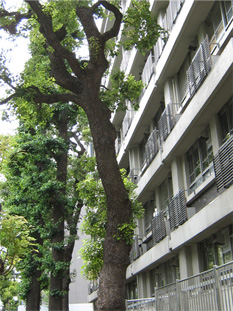Our History
The Institute of Biomaterials and Bioengineering is an offshoot of the Dental Materials Laboratory attached in 1938 to the Tokyo Dental High School. In this laboratory, studies on metal dentures were performed until the destruction of the school by World War II in 1945.
In 1946, when the school was evaluated to university status and named Tokyo Medical and Dental University, the President Masaru Nagao stressed the necessity of an institute for research into dental materials to enrich the divisions of engineering sciences in dentistry, since he was convinced that dentistry should be a body of learning which could be supported by both medicine and engineering sciences like the two wheels of a cart.

Technically, dental care depends largely on therapeutic devices and quality of materials. Japanese dental instruments and materials before World War II were inferior to those of foreign countries. Moreover, during and just after the war, extreme deterioration in quality caused anxiety to the health of the people.
Under such circumstances, the Research Institute of Dental Materials was attached to Tokyo Medical and Dental University in April 1951 as an integrated institution pursuing improvement of the quality of dental devices and materials.
This institute was organized at first into five research sections: Metals, Ceramics, Organic Materials, Mechanical Engineering, and Chemicals, as well as an Administration section under the concurrent directorship of President Nagao. In 1961, another research section, Electrical Engineering, was added which started on investigative activities in electronics and use of electronic computers.
In 1964, the six research sections of the institute were renamed, respectively, as the Division of Metallurgy, the Division of Inorganic Materials, the Division of Organic Materials, the Division of Medical Chemistry, the Division of Applied Mechanics, and the Division of Electronic Engineering.
As the one and only institution founded in Japan for basic and applied research into dental devices and materials, this institute played a leading role in academic as well as industrial fields. Research results were published annually in the Reports of the Research Institute of Dental Materials, which greatly contributed to the development if dentistry.
The enrichment of the research staff and facilities in this institute, and also an urgent need for medical engineering in Japan, especially concerning the application of electronic devices to medicine or development of artificial organs, changed the character of this institute. Hence in 1966, the institute was renamed the Institute for Medical and Dental Engineering, where the research field was extended further to biomedical engineering, in addition to the previously described dental devices and materials.
Simultaneously with the change in name, an independent building was newly constructed at the Kanda-Surugadai campus, to which all of the institute had moved from the Yushima campus by 1967. New extensions of the building were completed in 1975, but it is still necessary to overcome the shortage of space for later-established research divisions.
The following research divisions were added later: Instrumentation Engineering in 1967, Biocybernetics in 1972, Molecular Biology in 1978, Functional Polymer in 1981 (abolished in 1991), and Biofunctional Materials in 1991.
More than thirty years have passed since change to the Institute for Medical and Dental Engineering. Meanwhile molecular and cellular researches of living body have progressed remarkably and wide variety of biomaterials have been developed. Then social demands for novel artificial organs have become great. In order to answer these demands, the institute was reorganized in 1999 as the Institute of Biomaterials and Bioengineering which was composed of three divisions; Biofunctional Molecules, Biomaterials and Biosystems. Furthermore, in order to strongly progress cooperation with medical and dental sciences, this institute was reorganized again in 2012 as the same institute name which was composed of four divisions; Biomedical Materials, Biofunctional Restoration, Medical Devices and Biomolecular Chemistry, and one center; Medical and Dental Device Technology Incubation Center (abolished after achieving its goals).
From the time of establishment onward, the following professors took the post of director for the term of years indicated in parentheses: Masaru Nagao (9), Eiichi Masuhara (3), Atsuyoshi Muramatsu (3), Ishi Miura (3), Eiichi Masuhara (6), Masayuki Ishikawa (3), Atsuyoshi Muramatsu (3), Masayuki Ishikawa (3), Eiichi Masuhara (2), Ishi Miura (2), Masayuki Ishikawa (2), Yoji Imai (3), Tatsuo Togawa (3), Nobuo Nakabayashi (3), Shojiro Inoue (2), Hitoshi Hamanaka (3), Kimihiro Yamashita (7), Takao Hanawa (6), and Yuji Miyahara (present).
The institute has been recognized for many years as one of the largest and most important institutions in the fields of biomedical materials and biomedical engineering research not only in Japan but in the world. It is expected to meet the challenges of these rapidly growing and clinically important subjects and to contribute finally to improving health and medical care.




